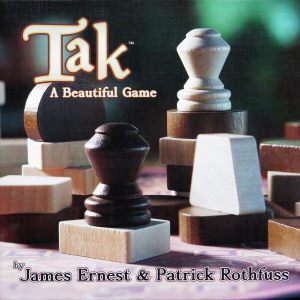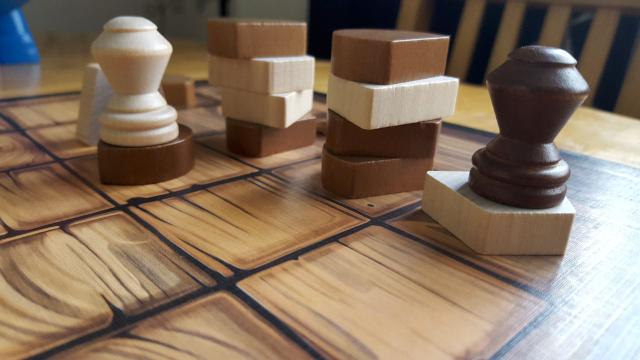
Tak describes itself as a “beautiful game”, which is a pretty bold statement to stick on the front of your box. And yet through a combination of wooden playing pieces and a fantastic looking double sided board it certainly achieved its self-inflating title, standing proudly as one of the better looking games around. There’s no intricate tiny miniatures, or hundreds of playing cards each with a piece of fine art on them; instead it’s a lesson in simplicity, a rustic offering which makes you feel like you could quite easily play this in a quiet, late-night bar – something which gave me a warm, fuzzy feeling as university memories of such places came flooding back. But the beauty isn’t all about the look and feel of Tak, beneath the great looking components and lovely theme are just a front for an easy to learn, but incredibly tricky to master strategy game that takes the achievement of chess, while leaving the more complex rulebook behind.
The idea of Tak is to create a path from one side of the board to the other using a series of stones in your colour. Stones can stack on top of each other, and even on top of the other player’s stones in most situations, and whoever can make an unbroken road across the board first wins the game. Simple. But not simple, obviously. To make things a little more awkward you can’t just plonk your stones down wherever you fancy and bag an easy win; instead you have two options on each turn – to place a stone, or move some stones.
If you choose to place a stone then you can put any of your pieces onto any empty space on the board. It doesn’t need to join onto your current road, as long as there isn’t anything else already occupying that space. Easy enough to understand, but getting this part right can make a big difference. You can confuse your opponent into thinking you’re trying something different, stand your stone upright to act as a wall that the other player can’t get through easily, or simply get yourself set up for the other possible action you can take on your turn: the move.

Moving your stones is where the strategy and tactics really come into play. You can move any stack of stones that you control – that is, any pile that has one of your pieces on top – by picking up as many of them as you want and placing them in a line by dropping them off the bottom of the pile bit by bit. You can drop as many as you want each time, so if there’s a pile with quite a few of your pieces in it you can transform a healthy opponent’s road into one which you practically dominate. A game which looks way beyond your control suddenly has a chance to turn on its head, all because you’ve been quietly setting up this stack which had the ability to totally transform things. But as you’d expect, getting a stack to this point isn’t an easy job either – stones only stack up as a result of moving others around; you can only drop stones on vacant spaces don’t forget, so there’s a sizeable amount of planning needed to build an effective stack, and that’s as long as the other player doesn’t notice what you’re doing and start moving things around to scupper your plan.
Tak’s complexity is also easy enough to scale; want a shorter, easier game? Then use the 4×4 or 5×5 grid layouts on the board. For something a bit harder to get your head round in terms of long term strategy then the board will go all the way up to 8×8, enough to give even the most forward thinking player a challenge to contend with. This nice idea means you can grow with the game, and as you become more confident in the techniques involved make a natural progression to trickier ways to play. If you just want a quick game to finish a night off, then go back to the smaller boards. Simple, effective, and a route to very impressive longevity.
So while the rules of Tak will take you moments to learn, this is genuinely a game that you’ll potentially play for years. Comparisons to chess are understandable but unfair, and Tak could be an excellent alternative to those unable or unwilling to learn the often-awkward rules of the old time classic. I can see this becoming a game that people will happily sit and play in Starbucks, drawing a small crowd as the game reaches its finale, without anyone finding it weird. It looks traditional, it feels traditional, and in time Tak could be a game that becomes traditional.
A beautiful game, indeed.
Tak
Available Now, RRP £54.99
Find your local stockist here

Leave a Reply